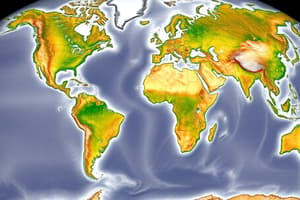Podcast
Questions and Answers
Which of the following is the largest type of tectonic plate?
Which of the following is the largest type of tectonic plate?
- Mantle plate
- Transform plate
- Oceanic plate
- Continental plate (correct)
What process occurs at the boundary between two oceanic plates?
What process occurs at the boundary between two oceanic plates?
- Volcanic eruption
- Mountain formation
- Earthquake
- Sea-floor spreading (correct)
What type of plate boundary is associated with the collision of two plates?
What type of plate boundary is associated with the collision of two plates?
- Divergent boundary
- Subduction boundary
- Convergent boundary (correct)
- Transform boundary
What occurs at a divergent boundary?
What occurs at a divergent boundary?
Which statement about the Mid-Atlantic Ridge is true?
Which statement about the Mid-Atlantic Ridge is true?
What is the main evidence supporting the theory of continental drift?
What is the main evidence supporting the theory of continental drift?
Which one of these statements is true about the hypothesis of continental drift?
Which one of these statements is true about the hypothesis of continental drift?
Which of the following is a strong evidence for continental drift?
Which of the following is a strong evidence for continental drift?
Which one of these statements is true about the theory of continental drift?
Which one of these statements is true about the theory of continental drift?
According to the information provided, which of the following is not a feature of tectonic plates?
According to the information provided, which of the following is not a feature of tectonic plates?
Flashcards
Continental Drift
Continental Drift
The theory that Earth's continents have moved over geologic time, and are still moving.
Alfred Wegener
Alfred Wegener
Scientist who proposed the theory of continental drift in 1912.
Tectonic Plates
Tectonic Plates
Large, rigid sections of Earth's crust that move independently.
Convergent boundary
Convergent boundary
Signup and view all the flashcards
Divergent boundary
Divergent boundary
Signup and view all the flashcards
Transform boundary
Transform boundary
Signup and view all the flashcards
Plate collision
Plate collision
Signup and view all the flashcards
Seafloor spreading
Seafloor spreading
Signup and view all the flashcards
Pacific Ring of Fire
Pacific Ring of Fire
Signup and view all the flashcards
Continental vs. Oceanic Crust
Continental vs. Oceanic Crust
Signup and view all the flashcards
Study Notes
Geography Quiz on Plate Tectonics: Continental Drift, Tectonic Plates, and Plate Boundaries
Plate tectonics is a fundamental branch of geology that studies the large-scale movement of the Earth's crust and the processes that shape it. Let's test your knowledge with a quiz on the key concepts of this fascinating subject.
Section 1: Continental Drift
Continental drift is the theory that the continents have moved over geologic time and that they are still moving. This concept was first proposed by Alfred Wegener in 1912 and has since been supported by numerous pieces of evidence.
-
Statement 1: Alfred Wegener first proposed the theory of continental drift in what year?
- A. 1900
- B. 1912
- C. 1925
- D. 1938
-
True or False: The hypothesis of continental drift was initially met with widespread acceptance by the scientific community.
- A. True
- B. False
-
Question: What is the main evidence supporting the theory of continental drift?
-
Statement 2: The existence of mountain ranges, such as the Andes, is a strong evidence for continental drift.
- A. True
- B. False
-
Statement 3: The theory of continental drift has been replaced by the theory of plate tectonics.
- A. True
- B. False
Section 2: Tectonic Plates
Tectonic plates are large, rigid sections of the Earth's crust that move independently of each other. There are three main types of tectonic plates: oceanic, continental, and transform plates.
-
Multiple Choice: What type of plate is the largest?
- A. Oceanic plate
- B. Continental plate
- C. Transform plate
-
Statement 1: The Earth's crust is divided into seven main tectonic plates.
- A. True
- B. False
-
Question: Which of the following processes occurs at the boundary between two oceanic plates?
- A. Sea-floor spreading
- B. Volcanic eruption
- C. Earthquake
- D. Plate collision
-
Statement 2: The Pacific Ring of Fire is a region where most of the earthquakes and volcanic eruptions occur.
- A. True
- B. False
Section 3: Plate Boundaries
Plate boundaries are the boundaries between tectonic plates. These boundaries can be classified into three main types: convergent, divergent, and transform boundaries.
-
Multiple Choice: Which type of plate boundary is associated with the collision of two plates?
- A. Convergent boundary
- B. Divergent boundary
- C. Transform boundary
-
Statement 1: The San Andreas Fault is an example of a transform boundary.
- A. True
- B. False
-
Question: What occurs at a divergent boundary?
-
Statement 2: The Mid-Atlantic Ridge is an example of a divergent boundary.
- A. True
- B. False
Answers
- B
- B
- The main evidence supporting the theory of continental drift includes the fit of the continents, the presence of similar rock formations on different continents, and the distribution of continental and oceanic crust.
- B
- B
- B
- A
- A
- A
- A
- A
- At a divergent boundary, two plates move apart, allowing magma to rise and form new crust, resulting in the formation of a mid-ocean ridge.
- A
How did you do on the quiz? Let me know if you have any questions or need further clarification on any of the concepts discussed.
Studying That Suits You
Use AI to generate personalized quizzes and flashcards to suit your learning preferences.




